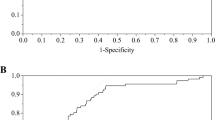Abstract
Background/Objectives:
Few user-friendly hydration assessment techniques exist for the general population to use on a daily basis. The present study evaluated void number over 24 h as a potential hydration assessment tool.
Subjects/Methods:
Male and female subjects collected urine for 24 h while adequately hydrated (n=44; 22±4 years, 168±16 cm, 73±15 kg) or fluid restricted (n=43; 22±3 years, 175±10 cm, 81±24 kg). As a control, participants were asked to void when feeling the ‘first urge to void’ on a commonly used urge scale and noted the volume of each void. For each sample, 24-h urine volume, osmolality (UOSM), specific gravity (USG) and color were measured in the laboratory.
Results:
As designed, the level of urge upon voiding was consistent throughout the study (2±0; ‘first urge to void’). Samples were classified by USG as either euhydrated (USG<1.020) or hypohydrated (USG⩾1.020). Grouping by UOSM did not change results. Euhydrated versus hypohydrated individuals had greater 24-h urine volume (1933±864 versus 967±306 ml, respectively) and lower urine color (2±1 versus 5±1), USG (1.012±0.004 versus 1.025±0.004) and UOSM (457±180 versus 874±175 mOsm/kg H2O; all P<0.001). Euhydrated individuals voided more than hypohydrated individuals over the 24-h period (5±2 versus 3±1 voids; P<0.001). Additionally, void number inversely correlated with hydration status as identified by USG (r=−0.50; P<0.05) and UOSM (r=−0.56; P<0.05).
Conclusions:
In conclusion, over 24 h, individuals with a higher void number were euhydrated (that is, had less concentrated hydration biomarkers) than those with a lower void number. Based on these data, void number might be utilized as a simple and feasible hydration assessment for the general public, as it utilizes no equipment or technical expertise.
This is a preview of subscription content, access via your institution
Access options
Subscribe to this journal
Receive 12 print issues and online access
$259.00 per year
only $21.58 per issue
Buy this article
- Purchase on Springer Link
- Instant access to full article PDF
Prices may be subject to local taxes which are calculated during checkout

Similar content being viewed by others
References
Raman A, Schoeller DA, Subar AF, Troiano RP, Schatzkin A, Harris T et al. Water turnover in 458 American adults 40–79 yr of age. Am J Physiol Renal Physiol 2004; 286: F394–F401.
Ganio MS, Armstrong LE, Casa DJ, McDermott BP, Lee EC, Yamamoto LM et al. Mild dehydration impairs cognitive performance and mood of men. Br J Nutr 2011; 106: 1535–1543.
Armstrong LE, Costill DL, Fink WJ . Influence of diuretic-induced dehydration on competitive running performance. Med Sci Sports Exerc 1985; 17: 456.
Hamilton MT, GonzaleZ-Alonso J, Montain SJ, Coyle EF . Fluid replacement and glucose infusion during exercise prevent cardiovascular drift. J Appl Physiol 1991; 71: 871–877.
Montain SJ, Coyle EF . Influence of graded dehydration on hyperthermia and cardiovascular drift during exercise. J Appl Physiol 1992; 73: 1340–1350.
Manz F . Hydration and disease. J Am Coll Nutr 2007; 26: 535S–541SS.
Armstrong LE . Challenges of linking chronic dehydration and fluid consumption to health outcomes. Nutr Rev 2012; 70: S121–S127.
Warren JL, Bacon WE, Harris T, McBean AM, Foley D, Phillips C . The burden and outcomes associated with dehydration among US elderly, 1991. Am Public Health 1994; 84: 1265–1269.
Armstrong L . Assessing hydration status: the elusive gold standard. J Am Coll Nutr 2007; 26: 575S–584SS.
Kavouras SA . Assessing hydration status. Curr Opin Clin Nutr Metab Care 2002; 5: 519–524.
Shirreffs SM . Markers of hydration status. Eur J Clin Nutr 2003; 57 (Suppl 2), S6–S9.
Armstrong LE, Pumerantz AC, Fiala KA, Roti MW, Kavouras SA, Casa DJ et al. Human hydration indices: acute and longitudinal reference values. Int J Sport Nutr Exerc Metab 2010; 20: 145–153.
Armstrong L, Maresh C, Castellani J, Bergeron M, Kenefick R, LaGasse K et al. Urinary indices of hydration status. Int J Sport Nutr 1994; 4: 265–279.
Athwal BS, Berkley KJ, Hussain I, Brennan A, Craggs M, Sakakibara R et al. Brain responses to changes in bladder volume and urge to void in healthy men. Brain 2001; 124: 369–377.
Sawka MN, Burke LM, Eichner ER, Maughan RJ, Montain SJ, Stachenfeld NS . American College of Sports Medicine position stand: exercise and fluid replacement. Med Sci Sports Exerc 2007; 39: 377–390.
Fletcher S, Slaymaker A, Bodenham A, Vucevic M . Urine colour as an index of hydration in critically ill patients. Anaesthesia 1999; 54: 189–192.
Birder LA, Kanai AJ, de Groat WC, Kiss S, Nealen ML, Burke NE et al. Vanilloid receptor expression suggests a sensory role for urinary bladder epithelial cells. Proc Natl Acad Sci 2001; 98: 13396–13401.
Blok B, Sturms LM, Holstege G . Brain activation during micturition in women. Brain 1998; 121: 2033–2042.
Bauer RM, Huebner W . Gender differences in bladder control: from babies to elderly. World J Urol 2013; 31: 1081–1085.
Acknowledgements
We thank the participants for volunteering and Erin Dougherty for help with data collection. This study was funded by a University of Arkansas Honors College Research Grant, the College of Education and Health Professions and the Office of Research and Economic Development.
Author information
Authors and Affiliations
Corresponding author
Ethics declarations
Competing interests
The authors declare no conflict of interest.
Additional information
Author contributions
MSG, JMB and SAK contributed to study design; JMB, JDA, MAG, CBR and MAT helped with data collection; JMB, MSG and NEM performed data analysis; all the authors were involved in writing and editing manuscript.
Rights and permissions
About this article
Cite this article
Burchfield, J., Ganio, M., Kavouras, S. et al. 24-h Void number as an indicator of hydration status. Eur J Clin Nutr 69, 638–641 (2015). https://doi.org/10.1038/ejcn.2014.278
Received:
Revised:
Accepted:
Published:
Issue Date:
DOI: https://doi.org/10.1038/ejcn.2014.278
This article is cited by
-
Combining urine color and void number to assess hydration in adults and children
European Journal of Clinical Nutrition (2021)
-
Hydration for health hypothesis: a narrative review of supporting evidence
European Journal of Nutrition (2021)
-
Reliability of 24-h void frequency as an index of hydration status when euhydrated and hypohydrated
European Journal of Clinical Nutrition (2016)



